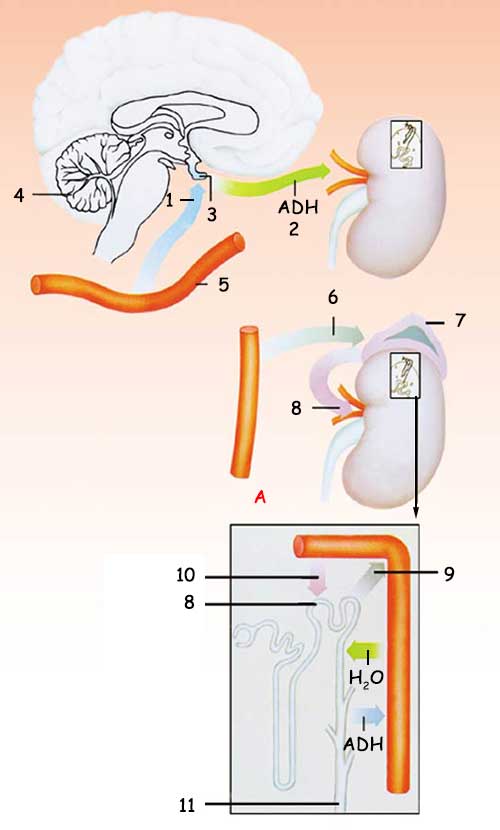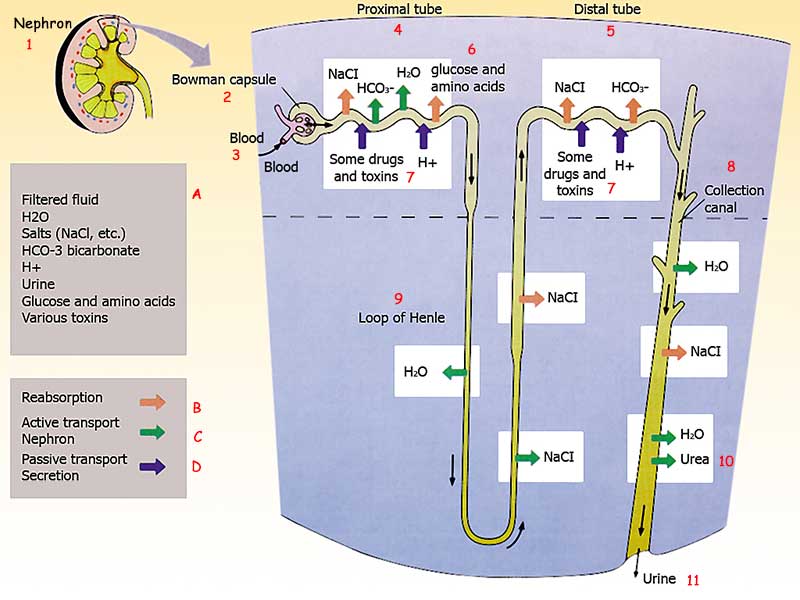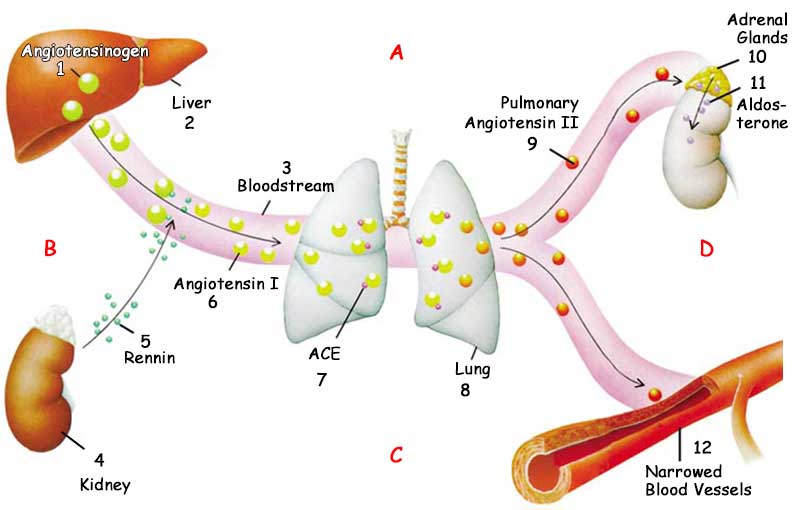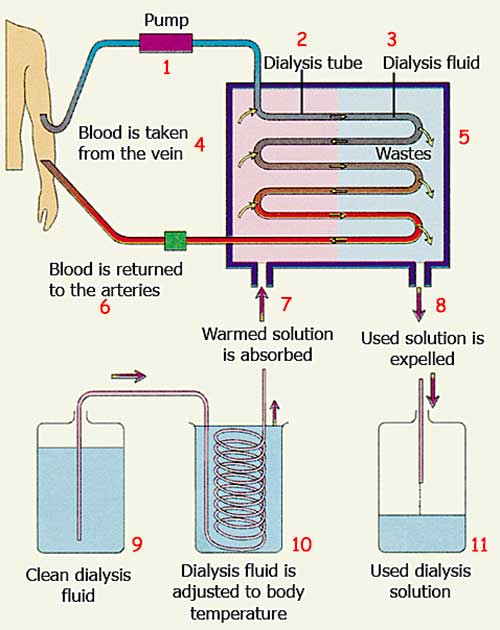Bigotry: The Dark Danger
The Human Miracle

DOWNLOAD THE BOOK
CHAPTERS OF THE BOOK
- Introduction: A Short Voyage Through The Human Body
- The Body’s Transport Network: The Circulatory System - 1/3
- The Body’s Transport Network: The Circulatory System - 2/3
- The Body’s Transport Network: The Circulatory System - 3/3
- The Digestive System - 1/3
- The Digestive System - 2/3
- The Digestive System - 3/3
- The Body's Purification Plant: The Excretory System - 1/2
- The Body's Purification Plant: The Excretory System - 2/2
- Splendid Communication within The Body: The Hormone System
- Your Internal Air-Conditioning: The Respiratory System
- A Resistant Structure: The Skeletal System
- Powerhouses in The Body: The Muscles
- Conclusion: Human Beings are Created By Allah
- The Deception of Evolution
< <
9 / total: 15
The Body's Purification Plant:
|
|||||||||||||||||||||||||||||||||||||||||||||||||
The Maintenance of The Water Balance in Our Bodies |
|
There is a great difference between the amount of water lost by a body doing some sort of work and the same body at rest. The amount of water filtered by the kidneys must therefore change. Yet it’s not the kidneys that stipulate this level. Again, the pituitary stimulates the kidneys by secreting the anti-diuretic hormone (ADH) in accordance with the body’s needs. The moment kidney cells receive this command, they slow down their blood-filtering process, and even begin to retrieve water molecules from the filtered-out liquid waste. There is another method the pituitary applies to regulate the water level in the blood. The ADH gland secretes slows the salivary glands’ production of saliva. The individual then feels thirsty, and is impelled to drink water. To ensure that we drink something, first and foremost, the pituitary gland has to know the importance of water. It must also know that when a person’s mouth feels dry, that body needs to replenish the water in its bloodstream. The pituitary must also know how to halt the working of the salivary glands. Every second of every day, the pituitary glands inside the heads of all the world’s billions of people determine how much water they need to drink, and oblige them to do so. This system alone is proof of how helpless human beings, and that they were created. Humans are helpless because using their own intellects, they cannot tell when the water level in their bodies has fallen. Were it not for that small piece of tissue that gives rise to feelings of thirst, people would not realize that their bodies needed water, and most of them would fail even to think of drinking before they fainted from dehydration. Human beings were created because no coincidence can install a small but exceedingly conscious organ in the brain that when necessary, can exert psychological pressure and oblige a person to take a drink. It is Allah Who has created human beings with the need to drink liquids and Who has taken all precautions to ensure they do so. |
What If You were Never Thirsty? |
|
There are systems that can perceive even the smallest changes in the level of water that take place in the body over the course of a day. Heading the list of these known as the hypothalamus, which is no larger than a pea in size and lies in a region of the brain. Immediately beneath the hypothalamus, the 1-centimeter (0.4-inch) pituitary gland secretes the hormone ADH, which journeys through the bloodstream and eventually reaches the kidneys. The kidneys contain special receptors that are compatible with this hormone in the same way as a key fits a lock. As soon as the ADH hormones reach these receptors, the kidneys immediately move to conserve water, and water excretion is reduced to a minimal level. If the kidney cells did not understand the pituitary hormone’s command to reduce water consumption, then we would have to drink 15 to 20 liters (4 to 5 gallons) of water a day in order not to die of thirst. Since this water would have to be constantly expelled from our bodies, we would be unable to sleep or sit down for very long. Yet even such an inefficient system wouldn’t be enough to keep us alive. We need to feel our need to drink water, and how much. To that end, Allah has created human beings together with the capacity to feel thirsty. Imagine that you never felt thirsty. Shortly after birth, you would die from lack of water. Since you had no feelings of thirst, you would be unaware that we were dehydrated and headed for death. The fact is, however, that people knows from birth that they need to drink, and how much, because their thirst is proportionate to their need. This system functions so perfectly that we never drink more or less fluid than we need, but always exactly the right amount. Allah, Who created us from a drop of water, created these perfect systems to meet our physical needs. He is the flawless Creator: He is Allah—the Creator, the Maker, the Giver of Form. To Him belong the Most Beautiful Names. Everything in the heavens and earth glorifies Him. He is the Almighty, the All-Wise. (Surat al-Hashr: 24) |
Sodium Regulation
The kidneys regulate the levels in the bloodstream of a great many substances of which you are quite unaware. Most people, for instance, do not know of the sodium molecules in their tissues and blood. Yet the kidneys work day and night to regulate the level of this element.
The kidneys contain special sensors responsible for monitoring the level of sodium in the body. If that level falls, these sensors immediately notify the sodium-absorbing cells in the kidneys.
It is most surprising that a cell should go about measuring the level of any particular substance, and possesses the consciousness to inform other cells of a change it identifies.
During filtration in the kidneys, a quantity of sodium is mixed with the fluid to be expelled as urine. When the sodium-absorbing cells realize that the sodium level in the blood has gone down, they seize the sodium molecules in the urine and return them to the body. The level of sodium in the bloodstream thus returns to normal.
Special pumps, located atop of these cells to let them trap sodium molecules, go into operation when needed to re-acquire sodium molecules for the body.
If that re-absorption mechanism in the kidneys did not exist, then our death from excessive water loss would be inevitable.
As you see, the connections between different parts of the body are flawless, and the regulatory mechanisms and precautions taken in the event of emergencies are incomparable. Any deficiency in the vitally important molecules in the blood is immediately identified by the relevant units, and begin work to remedy that deficiency. A chemical message is immediately dispatched to the relevant cells, which understand that message, act upon it and take the requisite precautions. Thanks to this flawless communication, which takes place in a very brief time, continued health is guaranteed.
 |
1. Water Level A. Effect of Hormones on Nephron
9. Sodium |
|
Allah has created the human body with a perfectly functioning interconnected feature. For instance, the control of the body fluids is arranged by a mechanism in the brain. When body fluids decrease, osmoreceptors (sensitive receptors) in the hypothalamus send a nerve message to the anterior pituitary gland. (1) At this signal, the hormone known as ADH is secreted. (2) The bloodstream carries this hormone to the kidneys, where it sets into motion the cells in the urine-collection sacs and causes them to reabsorb the same liquid. Every rational person can see that such an interconnected system could never emerge by chance. |
When you consider how every kidney cell knows what it will do, acts in an organized manner together with other cells, reads and understands the messages sent to it and does what is required of it, you can see that this chain of events represents a miracle from start to finish.
It is totally impossible for the components making up such a system to have formed by chance. As you have seen, to claim that such a system appeared in the kidneys by coincidence clearly reveals the logical collapse suffered by Darwinists. Every action taken by cells, which consist of proteins and can be seen only under the microscope requires a separate plan and reason. The presence of such intention in the cells is a clear indication of creation—just one of the signs of Allah’s infinite knowledge, intellect and power.
Those who grasp these facts need to waste no time in altering their lives in a way pleasing to Allah. This will be of benefit to all when they gather to account for their actions on the Day of Judgment. Allah has warned people of the Day of Judgment in these terms:
Allah is my Lord and your Lord, so worship Him. This is a straight path. The parties differed among themselves. Woe to those who disbelieve when they are present on a terrible Day! How clear will be their hearing, how perfect their sight, on the Day they come to Us; whereas today the wrongdoers are clearly misguided. Warn them of the Day of Bitter Regret when the affair will be resolved. But they take no notice. They have no faith. (Surah Maryam: 36-39)
The Kidneys and the Pressure in the Veins
One of the kidneys’ important functions is regulating blood pressure, determined mainly by the level of fluid in the veins. The more fluid in the veins, the higher the rise in blood pressure, which can damage many organs in the body.
Sensors on the anterior chambers of the heart perceive there is too much fluid in the veins. When the heart contracts with excessive fluid entering it, these sensors send a report of the situation to the brain, which then increases blood filtration by adjusting the width of the veins leading to the kidney.
 |
|
|
A.
B. Reabsorption |
1. Nephron |
|
Nephrons are micro-filters in the kidneys. Above is a schematic representation of the processes in the regions where secretion and reabsorption in the nephron are carried out. |
|
Let us now consider an imaginary example of the pressure measurement carried out in the anterior chamber of the heart and the adjustments in the body performed in the light of it. Imagine a room, totally isolated from the outside world. A human being lives in there, and must spend his entire life in there—to fulfill a very important responsibility.
The air pressure on the walls of this room changes constantly. This man’s task is to measure that pressure with special equipment. He must also notify the measurements he makes to an information-processing center, making thousands of reports every day, and there must be no errors in any of them. If he forgets to take a measurement, grows inattentive, or makes an inaccurate measurement, then the room he lives in, the building that contains that room, and the city it stands in will all be destroyed!
One cannot even imagine a person devoting his life to measuring the pressure on the chamber walls, never sleeping for a moment, and never making a mistake. Yet the events that take place in the body far exceed the bounds of this example. Cells in the walls of the heart’s anterior chamber do indeed devote their entire lives to measuring the blood pressure and reporting the results to the brain. The fact that these cells perform such an important function with such self sacrifice all their lives, are located in the anterior chamber of the heart, can take measurements and inform the brain of these, all shows that these cells were specially created.
The Message Concealed in the Fibers of the Heart
Located in the depths of the fibers of the heart are special molecules carrying a very important message that concerns not the heart, but another organ far distant from it. Under normal conditions, however, the molecules carrying the message, can never leave that region, because they are surrounded by powerful heart fibers.
So, what message do these molecules carry? And why are they located in the depths of the heart tissue? As we examine the answer to these questions, another miracle of creation emerges.
This molecule is a hormone known as atrial natriuretic factor. Only the kidneys can decipher the message it contains, instructing them to expel sodium from the body. 46
Why is a message to be sent to the kidneys concealed within the depths of the heart? And what does the heart have to do with the kidneys expelling sodium from the body? However, Allah has created the human body with thousands of interconnected systems. The concealing a message of concern to the kidneys within the depths of the heart is just one of these complex, interconnected systems.
High blood pressure—a rise in the force exerted by fluid in the veins—is a very dangerous condition that can be fatal unless precautions are taken. Increasing blood pressure causes the heart to expand, opening gaps between the muscle fibers, and the message molecules imprisoned there are released into the bloodstream and then reach the kidneys. The kidney, obeying the instruction, acts to expel the sodium from the body. Blood pressure thus returns to normal levels, and the heart continues to beat healthily.
What Happens When Blood Pressure Falls?
 |
|
|
A. Angiotensin is constantly manufactured by the liver. B. The kidneys secrete rennin as a response to stress resulting from changes in nutrition or excessive exercise. C. Angiotensinogen I is formed by the activation of angiotensin and rennin. Blood carrying angiotensinogen I goes to the lungs and enters into a reaction with the enzyme ACE. D. Angiotensinogen II forms when angiotensin I and ACE react. Angiotensin II has two main effects: The first is to stimulate the release of aldosterone from the adrenal glands; the second is to cause blood pressure to rise as the smooth muscles in the blood vessels contract. |
|
|
1. Angiotensinogen |
7. ACE |
|
The kidneys go into action to restore fallen blood pressure to normal. The above diagram represents the equilibrium maintenance system in the kidneys. |
|
The kidneys’ role in regulating blood pressure does not end there. When blood pressure is low, the kidneys secrete a substance called rennin from a cell with a special structure known as the JGA. Yet this substance has no direct pressure-reducing effect of its own.
This substance combines with a molecule called angiotensinogen, secreted by the liver, far distant from where it itself is produced, and transforms into the molecule angiotensin-1. Yet this resulting hormone has no serious effect on blood pressure. This hormone, present in the bloodstream, turns into a very different molecule: angiotensin-2, thanks to an enzyme called ACE which is present in the lung and serves only to break down the molecule angiotensin-1.47
This molecule, produced at the very end of the process, is the hormone that affects the veins and raises blood pressure back to normal levels. If that molecule did not exist, then none of the “earlier” hormones produced before it would have any effect on blood pressure. The molecule angiotensin-2 only contracts the veins after combining with sensors located on the surface of the vein and thus increases blood pressure.
The angiotensin-2 molecule does more than this to raise blood pressure. The bloodstream transmits the molecule to a gland above the kidneys. Certain cells in this region release into the blood a molecule called aldosterone, which these cells produce only after combining with angiotensin-2. When this happens, blood pressure begins to rise under the influence of another mechanism. By combining with the special receptors on the kidney’s collecting channels, the aldosterone molecule permits the body to re-absorb sodium molecules expelled in urine. 48 The sodium molecules then raise the blood pressure by increasing the density of the blood.
Without doubt, the effects of these substances are interconnected. Since not a single one of these could have come about by chance, it is even more impossible for all of this system’s components to have emerged by coincidence in the human body. Coincidences cannot give the kidneys their ability to understand, nor the necessary initiative to adopt various measures.
To claim that the order of the dozens of substances and mechanisms used to regulate blood pressure came about by themselves is a form of behavior unique to people blindly devoted to the theory of evolution, who have adopted it as a belief system. Indeed, evolutionists have admitted in various ways that theory is only a belief, and flies in the face of all the facts. One of these admissions reads as follows:
From my earliest training as a scientist, I was strongly brainwashed to believe that science cannot be consistent with any kind of deliberate creation. That notion has had to be painfully shed. At the moment, I can’t find any rational argument to knock down the view which argues for conversion to Allah. We used to have an open mind; now we realize that the only logical answer to life is creation—and not accidental random shuffling. 49
Clearly and irrefutably, all the scientific facts that evolutionists have had to admit show the existence of a Creator Who has dominion over everything—in other words, the existence of Allah.
Can Your Kidneys Possess Medical Information?s |
|
|
Your kidneys constantly measure the level of erythrocytes in the blood that’s pumped through them. The figures are immediately analyzed by the sensitive receptors and the necessary steps taken.
In the event they detect any reduction in the blood being filtered, special cells in the kidneys secrete a hormone known as erythropoietin. The hormone manifests its effect not in the kidneys, but in the bone marrow. This hormone notifies the bone marrow’s main blood-producing cells that the number of erythrocytes has declined, at which erythrocyte production is accelerated. More erythrocytes are released into the bloodstream, and the level of erythrocytes is thus kept balanced. But the kidney cells take the initiative to put the necessary steps into operation. Cells in the bone marrow decipher this hormone’s message sent from the kidneys and act accordingly. In addition, these processes all take place in the same way in every one of the billions of humans on Earth. In all these processes, the cells demonstrate a very clear intelligence, and the source of that intellect needs to be questioned. It’s impossible to claim that the cells arrived at that intellect by themselves or by chance. Allah installed that intelligence in the cells and inspired their behavior in them. There is no other power but Allah. |
Imitation Kidneys
|
1. Pump
4. Blood is Taken from The Vein
6. Blood is Returned To The Arteries
9. Clean Dialysis Fluid If the kidneys lose their function or work insufficiently, dialysis machines are used to replace them. Yet dialysis machines cannot replace the ease of use, dimensions or processing speed of the body’s renal system. Thanks to this perfect creation of Allah in an exceedingly small space, we are unaware even of the processes taking place inside our bodies. |
 |
In the event that organs fail to function properly, present-day technology places artificial devices to replace them at the disposal of medical science. If the kidneys fail or cease to function properly, dialysis machines have been developed to function as a blood- purification system. In these machines—incomparably larger than the kidneys themselves—blood is passed through various mechanisms and cleansed of such toxic substances as uric acid.
These machines work by simple diffusion, in which blood passes from a very high-density environment to a low-density one. Blood from an artery is pumped through a tube into the dialysis machine, containing fluid that’s similar to blood plasma in terms of oxygen richness and salt concentration. As blood is pumped through the tubes, waste products such as urea are diffused into the dialysis fluid, while needed substances such as erythrocytes and proteins remain in the dialysis tubes. During this process, the device lightly shakes the dialysis fluid, thanks to which waste products in the blood are separated out and the blood is made suitable for being returned to the body. If required, glucose is added to the dialysis fluid and again passed into the blood by means of diffusion.
The purified blood is returned to the arteries using another tube. During this process, the dialysis fluid is constantly renewed and maintained at the equivalent of body temperature, lest the patient suffer hypothermia.
A full dialysis takes some four to six hours, during which the dialysis fluid is changed several times. Patients are subjected to the process two or three times a week. Yet dialysis can never replace the normal kidney. 50 Even the most effective dialysis machines can prolong a patient’s lifespan by only a few years, and most patients eventually die.
Everything in the human body has been perfectly created. Medical research seeks to develop technology that’s able to produce features comparable to the human body’s. Yet it is impossible to install artificial devices into spaces as small as those in the body.
The systems installed by Allah in the human body is incomparable in all aspects. A person must regard this as a blessing from Allah and to give thanks to Him at every moment.
Allah is He Who appointed the night for you so that you might rest in it, and the day for seeing. Allah pours out His favor on humanity but most people do not show thanks. That is Allah, your Lord, the Creator of everything. There is no deity but Him—so how have you been perverted? That is how those who deny Allah’s Signs have been perverted. (Surah Ghafir: 61-63)
Which has The More Superior Characteristic—A Dialysis Machine, Which is The Product of Advanced Technology, Or A 5- To 10 cm (2-to 4-inch) Kidney? |
|||||||||||||||||||||
As we have seen, the kidney is incomparably superior to a dialysis machine. But could a dialysis machine be the product of chance? What if someone told you that this machine, produced with advanced technology, had come into being by itself?
Since it is impossible for a dialysis machine to have come into existence by chance, could a kidney, so incomparably superior, have done so? The kidney, with all its features, is the product of a superior intelligence and power. It is one of the works of Allah, Who creates all things flawlessly, in a perfect order. |
Footnotes
45.Arthur C. Guyton, Textbook of Medical Physiology, W.B. Saunders Company, 7th Edition, 1986, p. 614.
46.Arthur C. Guyton, Textbook of Medical Physiology, W.B. Saunders Company, 7th Edition, 1986, p. 613
47.Montgomery, Conway-Spector-Chappel, Biochemistry, Mosby-Year Book, Inc., 1996, p. 604 
48.Arthur C. Guyton – John E. Hall, Textbook of Medical Physiology, Guyton & Hall, 9th edition, p. 345
49.Chandra Wickramasinghe, Interview in London Daily Express, August 14, 1981.
50.Arthur C. Guyton and John E. Hall, Textbook of Medical Physiology, Guyton & Hall, 9th edition, p. 420.
9 / total 15
You can read Harun Yahya's book The Human Miracle online, share it on social networks such as Facebook and Twitter, download it to your computer, use it in your homework and theses, and publish, copy or reproduce it on your own web sites or blogs without paying any copyright fee, so long as you acknowledge this site as the reference.

